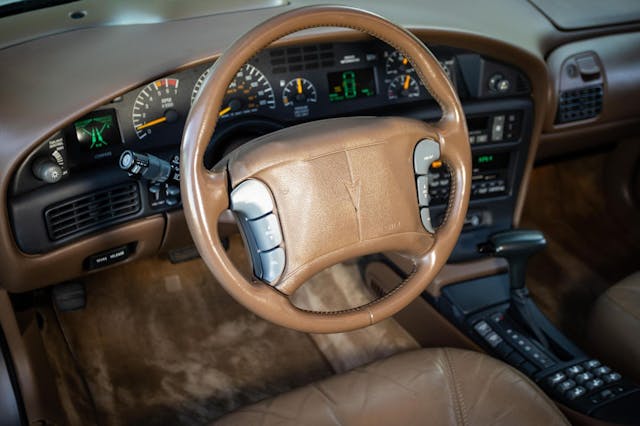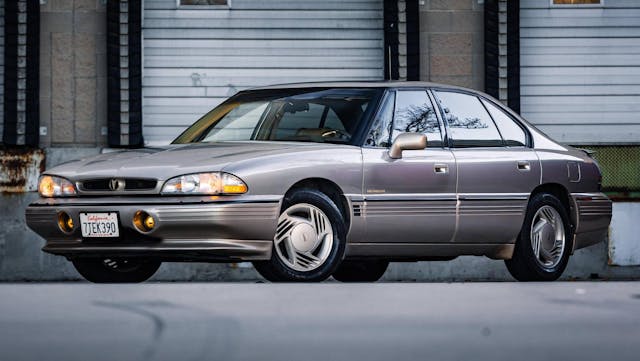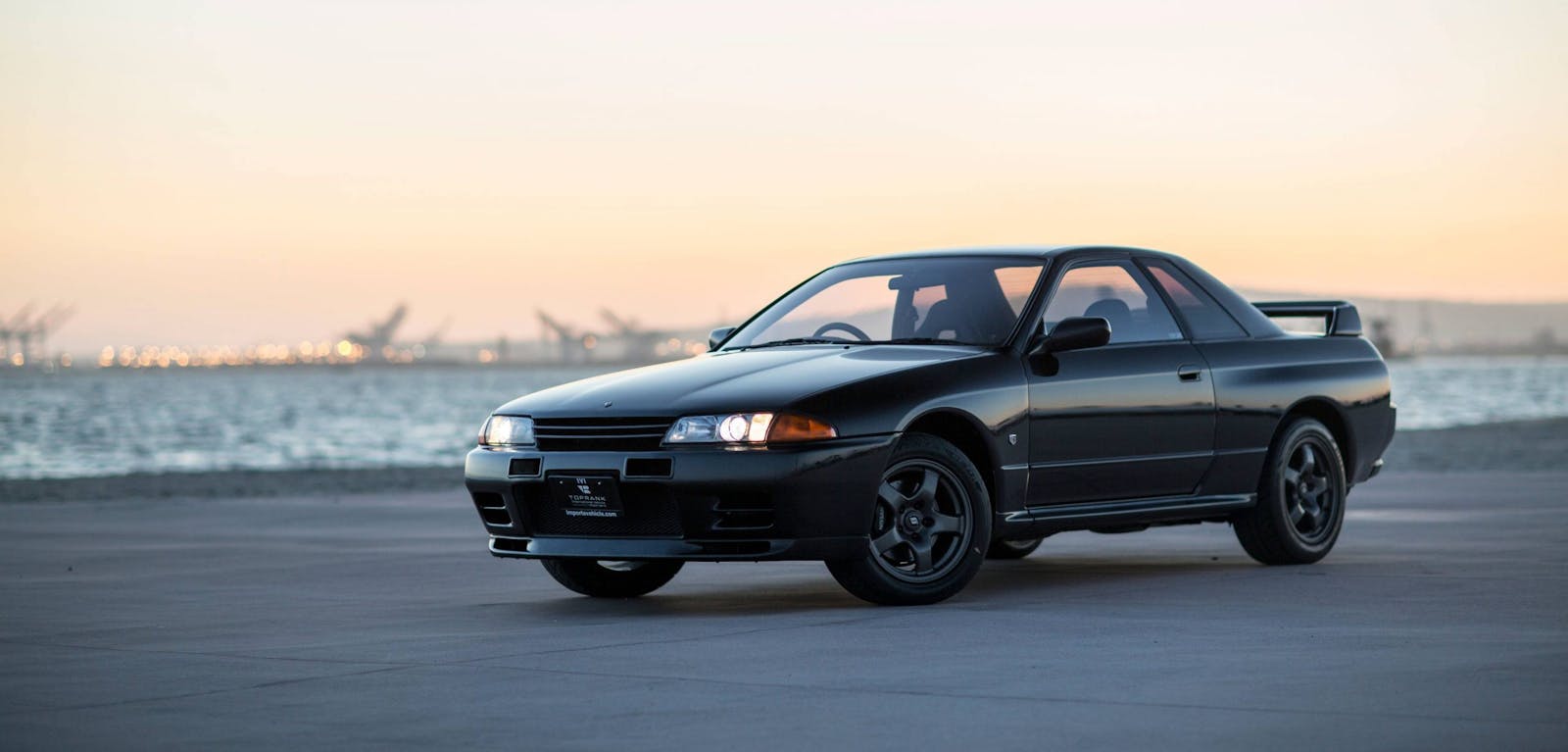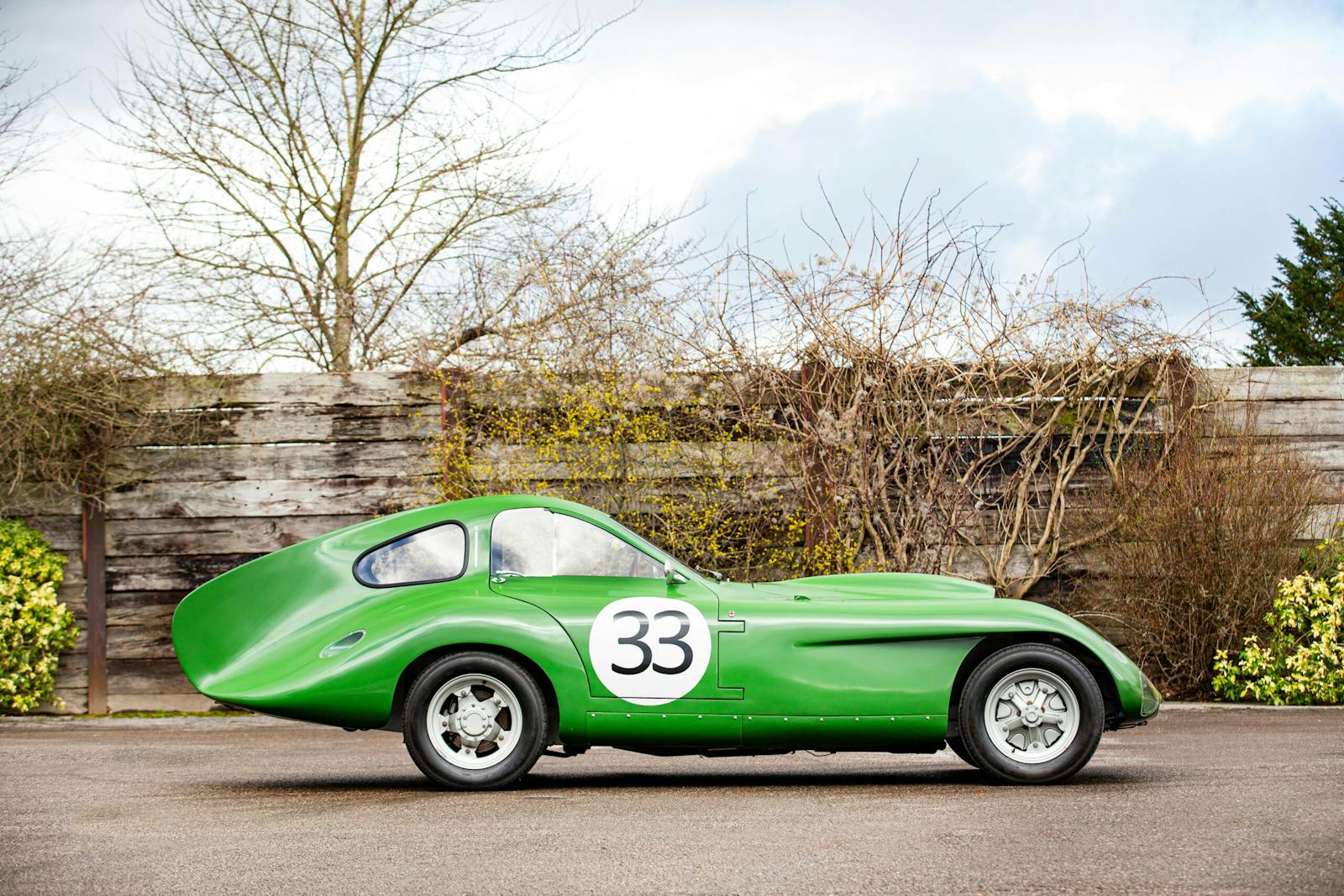’90s cars are hot, but not this honest American family car
Want a better understanding of what’s driving collector-car values? Sign up for the Hagerty Insider newsletter.
I grew up in a family that exclusively bought General Motors vehicles. Why this was the case, I can’t really say. We lived on the East Coast, and no one we knew worked for any of the Big Three. Nowadays any kind of loyalty carries a tinge of hyper-partisanship; back then, it felt more like a simple fact. Just as we happened to be Jews and happened to be from New England, so we happened to always have a front-drive GM blob in the driveway.
I was brought home from the hospital in a Chevrolet Celebrity, which was traded for a Pontiac Sunbird and then a procession of Bonnevilles. I spent middle school climbing into the back seat of a Chevrolet Monte Carlo (the two-door Lumina variant), which was upgraded—thrillingly, to me at the time—to a Pontiac Grand Prix GTP.
All of this is a long way of explaining my joy at seeing a 1993 Pontiac Bonneville SSE Supercharged sell for $6061 (including fees) on Cars & Bids.
“Supercharged,” in this and practically every other case for General Motors in the 1990s and early 2000s, referred to a boosted version of GM’s venerable 3.8-liter V-6. It was, even in 1993, far from state-of-the-art—an OHV, iron-block engine that dated back to 1960s Buicks. Yet it produced 205 hp and 260 lb-ft of torque, which was a whole lot in 1993.
By the time this “3800” powerplant officially left the scene, in the 2007 Pontiac Grand Prix GT, it made 260 hp and 280 lb-ft of torque. Readily available bolt-ons, namely a smaller pulley, easily pushed output past 300 hp with little risk to the engine (the transmission was another matter).
I’ll come right out and say it: These were great engines.

Lest I get ahead of myself (or in case I already have), it’s worth adding that the Bonneville SSE was not a great car, and neither were any of the other GM front-drivers of the era. By 1993, Japanese automakers had utterly perfected the family sedan—one could make the case that the 1991–96 Toyota Camry, a Lexus in all but name, is the greatest front-drive family sedan of all time. Ford had battled back with the best-selling Ford Taurus and even Chrysler, under the auspices of Bob Lutz, was rolling out slick-looking, “cab-forward” LH-platform cars. GM was otherwise occupied.
In the 1980s the General had thrown billions at front-drive cars that, even when new, failed to match the refinement of class leaders. It entered the 1990s posting losses that were, at that point in the company’s history, unprecedented. The hard times manifested themselves in hard interior plastic panels and overall poor fit and finish. (I can recall, even as an eight-year-old, noticing paint runs in our white 1993 Bonneville SE).
Although practically all GM brands and cars suffered, few fared worse than the once-proud Pontiacs, which continued to be marketed as performance cars but increasingly failed to keep up with competition. These Bonnevilles accelerated well and cruised the highway with languid ease but lacked the agility of a contemporary Nissan Maxima, to say nothing of the era’s BMWs.
Not that my parents—or hundreds of thousands of other parents—were really cross-shopping 5 Series and the like. GM was losing market share, but still built more than one out of every three cars sold in the United States when this Bonneville found its first owner. Since then, this beige and brown family sedan has clearly lived a pampered existence, racking up 167,000 miles and showing only minor wear to its heavily bolstered driver’s seat. The 1990s GM gimmickry gadgetry, including a head-up display and primitive trip computer, now lend a distinct time-capsule feel, although it’s hard to say if they all work going just by the photos.

Hagerty fielded only a handful of calls from people interested in insuring 1992–1997 Bonnevilles in the past year. The median value cited is $6000, making this sale right on the money. Even the best American cars of this era have by and large been left behind as 1990s vehicles appreciate. These front-drive GM sedans, far from the best, are and remain an automotive underclass of a sort. And yet, they were always there, serving honestly in the background and, more specifically, in my family’s driveway.
It’s nice to see you, old friend.
***
Check out the Hagerty Media homepage so you don’t miss a single story, or better yet, bookmark it. To get our best stories delivered right to your inbox, subscribe to our newsletters.



I started work at the Buick admin building in ’93 writing service manuals for the C/H cars. I worked for EDS and we had just recently obtained the contract to write service manuals and start a service engineering effort for GM’s C and H full size vehicles. We were in the basement and Buick engineering was upstairs. My childhood friend’s Dad worked there and showed me around and introduced me to some of the folks who worked on the Buick Turbo V6 engine. The Buick Y Job and a few other old prototype cars were in the lobby. We also had a labor time shop in the back of the Buick City Assembly Plant. The plant was a mile long, and we had passes to drive our vehicles into it to get to the back where the garage was. After working at Buick City, many in my group moved over to the CLCD (Cadillac Luxury Car Division) engineering building. They didn’t have room for me, so they asked me to move to the labor time garage. I poked around a bit over there and found an unused office near the PEP vehicle garage which is like a big empty warehouse, and after cleaning it out, I moved in there. I had to string my own phone line and clean and vacuum it myself, but it was nice to have my own office. No one to talk to though, so it got a little lonely sometimes. I wrote the IP R&R section of the service manual among others, and afterwards wrote air bag service diagnostics. Buick City and Bick Admin building are all gone now. I feel privileged to have work there. So much history right back to the beginning of the automobile.
Thanks for the memories, Dean! I worked at the Buick admin building in ’91 for EDS. I later owned a ’94 SSEi supercharged like the Bonneville in David’s article….with a smaller diameter pulley installed, of course!
The 1980’s was a mess for all brands. GM went to FWD, Ford had issues like my T Bird that had the worst paint job, a sway bar that was falling off new, blown head gasket and doors sagging by 65,000 miles.
Then Chrysler was a total mess with smoking 4 cylinders in K cars with back door hinges that were cotter pins.
Pontiac was a division fighting for it life. They were set to die but the new TA and Fiero brought attention to the brand and the large volume of Grand Ams really saved them and moved the target to Olds.
While the new Pontiacs were not really Pontiacs at least they were the most interesting of all the new GM cars. I had a 1990 GP GT, 40th Anniversary SSEI and later a GTP Comp G Grand Prix. While not exactly GTO’s or 2+2’s they were interesting cars that still have a cult following.
I even had a couple fly up to Ohio from Florida to by my Bonneville with over 100,000 miles as they wanted a clean one and had trouble finding the anniversary model in good shape.
There was a good deal of performance parts for these cars and they did remain popular over many forgettable cars like by fathers Euro Sports.
Even at the Pontiac Nationals there are a number of these newer models on the show field but a number of them on the drag strip at the event. Some are turning very fast times for the traction challenged FWD cars.
People can say what they like but I drove all my Pontiacs over 100K miles with no major issues. They were fun and often people did like the looks. I do wish they had been RWD but it is what it is. Now my wife is into the SUV thing and at least we have a GMC today that to be honest drives much like the SSEI and is about as fast but with AWD. It is not as cool looking but still reminds me of the car and how it handled.
I still have my Fiero that will remain with me. It was my First new car and while others will come and go it will remain.
Note I came home from the Hospital in a 1960 Ventura and my son in the SSEI. I grew up with a number of ex Kanafel Pontiac Racers and was lucky enough to ride and drive some of the greatest Pontiacs over the years. That is why I separate the new from the old models. Once they lost the Pontiac V8 there really was no Pontiac as it lost its heart.
We had a Catalina 2+2 with a 389 cubic inch engine and 4-speed manual transmission. It was a very cool car!
92-97 Bonnevilles will fall into the trap of not being respected enough to be collected/supported, making it hard to keep one going.
Parts will be a pain (unless shared with a popular model or corporate cousin) and there is no pretense of recouping investment like there is with a Firebird.
I’d drive one don’t get me wrong. But if I’m hunting 90s Pontiacs these aren’t top of my list.
I bought a slightly used rental 2001 maroon Bonneville SE in 2001 with 17k miles on it when we figured out the baby seat wasn’t going to fit in our 97 Chevy Silverado extended cab. Drove it for 13 years and 245,000 miles. Then I bought another used 2004 SE with 120k miles on it and put another 65k on that one. Sold it when the radio and A/C went out and it was going to be a $2500 bill to fix. Then I bought a used 2003 SSE a few years ago with 120k miles and am currently at 180k with it. It’s a big comfortable car that cruises just fine and makes a reliable daily driver. And I can do a lot of the maintenance myself after driving them for 22 years.
Maybe mine will be a classic someday. At least it will qualify for classic TX license plates in a couple of years. 🙂
I once spoke with a Buick engineer about the 3.8 as they were introducing it in the Holden Commodo, albeit as rear wheel drive. His take was that although it was a bit agricultural in comparison with the motor it replaced (a Nissan straight 6 with a turbo option), coupled with an auto there was great step off which most motorists appreciated.
The Bonnies are great cars that can go 300K miles with no issue. The most major issue is the rust at the gas door and quarter panel on the last two gens.
Parts are shared mechanically but the body and trim parts can be difficult for the SSEI models.
The biggest problem is it was FWD. Pontiac did a good job selling it as performance but the FWD did hurt it. GM did build a RWD version of it and use a Chevy V8. It is a shame it never went to production that way. The Pontiac engineers were rebels to the end.
The revamped Buick engine did its job at a time GM had little money to invest into a new engine program.
We’ve had a number of 3.8 powered vehicles and found them pretty bulletproof. My preference is for the Buick H and C bodies. I bought a ’92 Park Avenue in 2000, in such nice shape I’ve only used it as a summer car. Several Le Sabres served as reliable winter beaters. They’re as comfortable as a living room sofa and the ’92 would still be my car of choice for a highway trip.
I owned a 1985 Chevy Celebrity Eurosport wagon. I’ve always thought they were among the nicest-looking station wagons on the road.
I never liked the Pontiacs with all the plastic cladding.
This car would have been much better looking if the bumpers and side moldings didn’t have so many grooves, the wheels were less futuristic, and they had put a different spoiler on it. Pontiac had a tendency to go overboard with funky details on moldings and wheels that looked. Sometimes less is better.
I purchased a 1988 Bonneville LE with low miles. I kept it until I thought the wheels would fall off, but they never did. At 120K miles, +/-, I replaced the fuel injectors. That was it. Sold the car to a friend and they had it for many more years. It was one of the most comfortable and reliable cars I have ever owned. I had 5 spoke, 16″ wheels on it and back in the 90’s, those were rare. Funny how I don’t have a single picture of that car.
That Bonneville looks a lot like a 1996 Oldsmobile I had. Basically decent car for what it was. It did have one neat feature that I have yet to see elsewhere – multiple sun visors. Behind the big visor was a small one so you could block forward and side windows at the same time. I used it regularly and wish GM put that feature on other cars.
Bought a ’91 (I think) SSEi new, surprised my wife…it fit 3 kids in car seats at the time.
Cupholder directly above the 9 (NINE!) seat adjustment buttons, and they stop working when a yoohoo is spilled on ’em…
Alternators went bad in about 12,000 miles, or 3 months in the summer, due to the minimal output and maximum electrical load…
Altogether, a really bad car…
If you were replacing alternator every 12,000 miles, your particular car had an electrical fault. Most of them lasted the life of the car. I worked in a Pontiac dealer service department, later at GM Technical Assistance. Alternators were not a problem.
Oof – I can smell those pictures….
Everyone should own at least one old American luxury car!
Not only did I work as a Pontiac salesman in the mid 90’s shilling those FWD blobs, but I and my family owned more than a few. My favorite was the 2000 GTP coupe that served me well throughout my 4 year tenure. There’s no denying the power and reliability of the 3800 SC engine. I had the 240 hp/280 tq version, and with less than a 1000 dollars in easy modifications, it was running consistent 14.0s at 100 mph at the local track. More than one Maxima or 3 series saw my tail lights. Add to that heated leather seats, dual zone climate, and a HUD, and it was one slick ride on a budget. If you can get past the cheap plastics and FWD stigma, they’re good cars.
Although I’m more of a 2 seater guy, I would really love to own a riviera with the supercharged engine. If one comes up in my area at a great price, I will find out hard to say no.